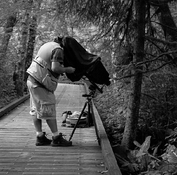The "tonality" in my example came from three things mainly.
1) The direction and character of the light;
2) How the subject looked - the presence of deep shadows and luminous reflections arrayed (fortuitously) in a pleasing manner; and
3) the reflectivity of some of the subject.
It is taken with the camera (Mamiya C330) pointing almost straight down, with me and my tripod hanging over the edge of an elevated wooden walkway. I metered using an incident meter pointing up toward the forest canopy and overcast skies. IIRC, it was T-Max 400 developed in replenished HC-110 1 + 49 (but it might have been Plus-X).
The negative appears quite thin to the naked eye. It prints beautifully. As an aside, I think most beginners seem to want thicker negatives than I prefer. But then, some very experienced photographer friends prefer those thick negatives as well.
This shot is taken on the same roll, from almost the same place, while (obviously) pointing the camera in a different direction. It's subject is another Photrio moderator

The first example image was taken looking over the left side of the walkway, from a location just out of the field of view in the second image.
I share the second image here because it gives an indication of the light.
1) The direction and character of the light;
2) How the subject looked - the presence of deep shadows and luminous reflections arrayed (fortuitously) in a pleasing manner; and
3) the reflectivity of some of the subject.
It is taken with the camera (Mamiya C330) pointing almost straight down, with me and my tripod hanging over the edge of an elevated wooden walkway. I metered using an incident meter pointing up toward the forest canopy and overcast skies. IIRC, it was T-Max 400 developed in replenished HC-110 1 + 49 (but it might have been Plus-X).
The negative appears quite thin to the naked eye. It prints beautifully. As an aside, I think most beginners seem to want thicker negatives than I prefer. But then, some very experienced photographer friends prefer those thick negatives as well.
This shot is taken on the same roll, from almost the same place, while (obviously) pointing the camera in a different direction. It's subject is another Photrio moderator


The first example image was taken looking over the left side of the walkway, from a location just out of the field of view in the second image.
I share the second image here because it gives an indication of the light.





 Oh and I finally retired that minky old vest!
Oh and I finally retired that minky old vest!